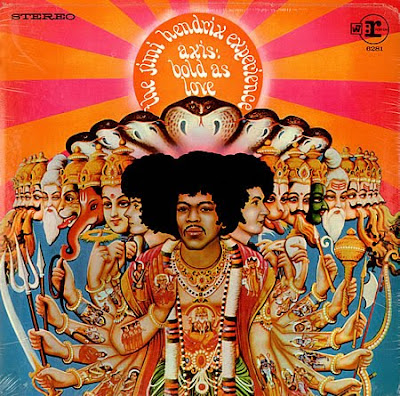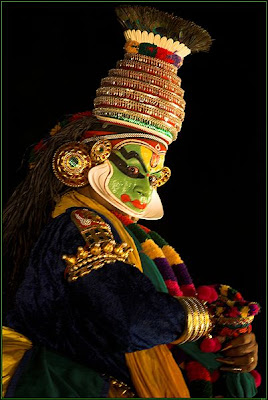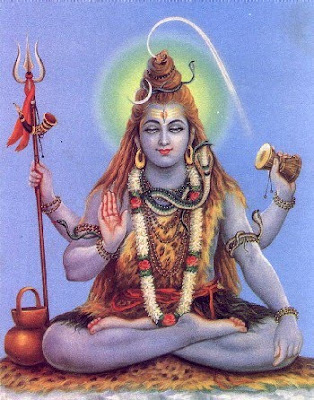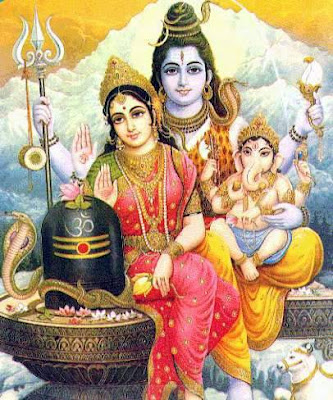
The genre of the music on this album is psychedelic rock, blues rock and hard rock. The album was first released in the UK in December 1967.
This album cover began as a photographed copy of a mass produced religious poster of a Hindu painting where Jimi Hendrix was later painted in. This painting is known as 'Virrat Purushan-Vishnuroopam' which is a term within Hinduism which refers too:
- The Universal form revealed by Krishna in the Bhagavad Gita.
- A name of the deity, Shiva.
- The yoked horses of the Sage, Brhaspati.
- Trisiras the three-headed son of Tvashta.
- One of the seven tongues of fire in reference to the god, Agni.
Krishna in the Bhagavad is often depicted as a boy playing a flute and he is generally show in paintings with blue skin. Looking at the album cover, we can see that at the back of the picture there is a man playing a flute and all around him the colour blue has been picked as the background and this is the man in the poster. Krishna is often shown with a yellow dhoti and a peacock feather crown and on this part of the album cover, we can see that the man is wearing a yellow headpiece. In the performing arts the actor of Krishna is often painted green with black eyebrows and black around the eyes and this colour symbolizes the nature of the character, and looking at the cover we can see one green man on the right hand side and this could definitely be a reference to the performing arts depiction of Krishna.

However, Bhagavad Gita is a sacred hindu scripture considered amongst the most important texts in the history of literature and philosophy. The teacher of the Bhagavad Gita is Krishna and it begins before a battle with a Pandava price Arjuna realising that war was inevitable between himself and his relative Kaurava Prince Duryodhana. Both Duryodhana and Arjuna requested Krishna to support them in the war, since he possessed the strongest army, and was revered as the wisest teacher and the greatest yogi. Krishna offered to give his vast army to one of them and to become a charioteer and counselor for the other, but he would not touch any weapon nor participate in the battle in any manner. While Duryodhana chose Krishna's vast army, Arjuna preferred to have Krishna as his charioteer. From then on, they have been painted and even made into famous statues depicted in a chariot together and in the picture below, Arjuna matches the man on the album cover. Most of the characters on the Album cover are holding weapons such as spears and these weapons could be linked to the battle of Kurukshetra.

The Deity, Shiva, is seen as a supreme God, one of the five primary forms of God. In images he is generally represented as immersed in deep meditation. Looking at the album cover, Jimi is depicted as a God with many arms, draped in robes and colour. Shiva's particular weapon is the trident.His Trisul that is held in his right hand represents the three Gunas—Sattva, Rajas and Tamas. That is the emblem of sovereignty. He rules the world through these three Gunas.
Shiva is represented in many different forms and a seal discovered one form which I think could be the form represented in the original poster and then on this album cover. This seal, The Pashupati seal, meaing the Lord of animal-like beings, shows a seated figure surrounded by animals. In this particular form Shiva has three faces and on the album cover Jimi is depicted as having three faces and his hair is similar to Shivas, who is often referred to as hair in a Kaparda fashion (hair that is shaggy or curly). Also, Jimi is surrounded by animals on the left and right which are part of the original image.

The woman to the right of Shiva/Jimi is, I believe, the goddess Parvati, Shivas wife. Together they symbolise at once both the power of renunciation and asceticism and the blessings of marital felicity. According to Hindu past, Parvati gave birth to Ganesha without any form of participation of Shiva in Ganesha's birth. Parvati ordered Ganesha not to allow anyone to enter her house, and Ganesha obediently followed his mother's orders. After a while Shiva returned and tried to enter the house, Ganesha stopped him. Shiva was infuriated and severed Ganesha's head with his trident. When Parvati saw what had happened, she demanded that Shiva restore Ganesha's life at once. Unfortunately, Shiva's trident was so powerful that it had hurled Ganesha's head so far off that it could not be found. Finally, an elephant's head was attached to Ganesha's body, bringing him back to life. Ganesha is depicted in all images with this elephant head and is on the album cover.

The snakes on the cover, form a canopy over Jimi/Shiva. Snakes are worshipped in Hinduism. It is said the serpent on Shiva’s neck represents the endless cycle of birth and regeneration. Another symbolism is that the snake on his neck represents ego which once controlled can be worn as an ornament. Snakes, especially cobras, are said to carry ‘mani’ (rubies) in their head. It is said that these rubies served as a lamp during the night to Parvati and Shiva. The most famous association of Lord Shiva with snakes is during the churning of the ocean (Samdura Manthanam). Shiva drinks the poison halahala that came out of snake Vasuki, who was used as the rope in the churning. The blue throated Shiva is the result of swallowing the snake poison.
The sunshine and blue background where also added extras to the poster for the album cover.
Sites used in research:
http://en.wikipedia.org/wiki/Axis:_Bold_as_Love
http://www.hindu-blog.com/2007/02/about-snake-around-neck-of-lord-shiva.html
http://en.wikipedia.org/wiki/Shiva
http://en.wikipedia.org/wiki/Parvati
http://en.wikipedia.org/wiki/Bhagavad_Gita
http://www.koausa.org/Gods/God9.html
No comments:
Post a Comment